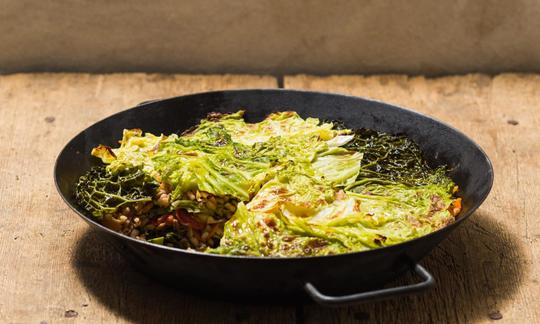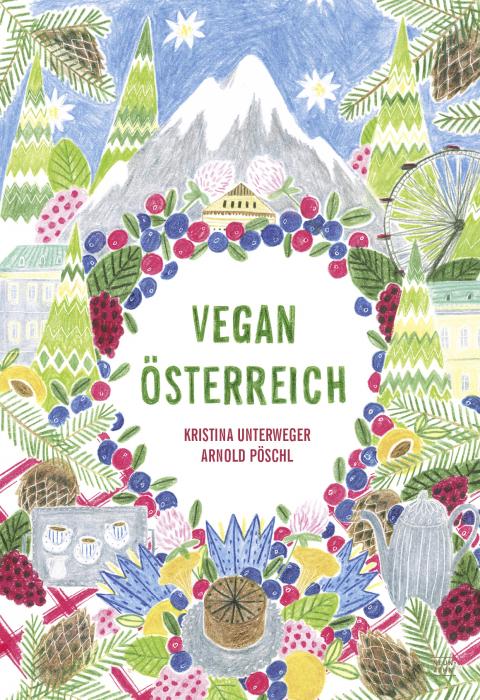Baked Savoy Cabbage with Spelt, Carrots, and Tomatoes
vegan
Ingredients (for servings, )
| Preparing the savoy cabbage | |
|---|---|
| 1 large | Savoy cabbage, raw (Savoy cabbage, organic?) (25 oz) |
| 1 liter | Drinking water, raw (organic?) (35 oz) |
| 1 tbsp | Table salt (table salt, raw?, organic?) (0.63 oz) |
| 1 tbsp | Caraway seeds (real caraway, raw, organic?) (0.24 oz) |
| For the filling | |
| 8 ½ oz | Spelled, raw (husk, fesen, vesen, organic?) |
| 500 ml | Drinking water, raw (organic?) (18 oz) |
| 1 tsp | Table salt (table salt, raw?, organic?) (0.21 oz) |
| 3 ½ oz | Zucchini, raw, (organic?) |
| 1 ¾ oz | Celery (bleached celery), raw (organic?) |
| 4 ⅓ oz | Carrots (carrots), raw (organic?) |
| 5 ½ oz | Tomatoes, raw (organic?) |
| 1 | Sweet peppers, red, raw (organic?) (5.8 oz) |
| 2 ⅔ oz | Celeriac, raw (organic?) |
| 2 ½ oz | Onions, raw (organic?) |
| 4 cloves | Garlic (organic?) (0.42 oz) |
| 1 tbsp | Olive oil (cold pressed, raw?, organic?) (0.47 oz) |
| 1 dash | Table salt (table salt, raw?, organic?) (0.01 oz) |
| 1 dash | Black pepper (organic?, raw?) (0.00 oz) |
| 2 tbsp | Marjoram (sausage herb), raw (organic?) (0.17 oz) |
| For the casserole dish | |
| 2 tbsp | Olive oil (cold pressed, raw?, organic?) (0.95 oz) |
Equipment
- skillet (frying pan)
- stove
- saucepan
- oven
- casserole dish (baking dish)
- sieve
Type of preparation
- cook
- fry
- bake
- chop or grind
- meld
- season to taste
- bring to a boil
- remove the skin
- peel
- drain
Preparation
Prepare the savoy cabbage
Cut around the stem while angling the knife toward the center of the head to remove the core of the cabbage. Carefully separate the leaves and cut out the hard ribs. Add the salt and caraway seeds to approximately 1 liter of water. Bring the water to a boil and remove from heat. Place the savoy cabbage leaves in the saucepan and let soak for about 30 minutes. Remove the leaves from the water and place on a clean cloth to dry.The original recipe calls for one large head of savoy cabbage.
We calculated the amounts listed in this recipe for 4 servings.
For the filling
Add 1 tsp salt and the spelt to 500 ml water and simmer until tender. Drain the cooked spelt in a sieve.While the spelt is cooking, you can save time by preparing the vegetables in the next step.
Wash and dice the zucchini, celery stalks, carrots, tomatoes, and bell pepper. Peel and dice the celery root. Peel and chop the onions and garlic. Sauté the chopped vegetables in 1 tbsp olive oil.
Add the spelt to the vegetables and mix well. Generously season with salt and pepper. Chop the marjoram and add to the vegetables and spelt. If you like, add a little soy sauce for additional seasoning.
The original recipe calls for ½ bunch of marjoram. This yields about 2 tablespoons when chopped. Use more according to taste.
Grease a casserole dish with 2 tablespoons of olive oil. Cover the bottom of the pan with a layer of cabbage leaves. Spread part of the filling on top of the leaves and cover with a layer of cabbage leaves. Continue layering with filling, leaves, filling, and finish with a layer of leaves. Drizzle a little olive oil on top.
Preheat the oven to 180 °C (350 °F) and bake on the middle rack for 20–25 minutes.
|
Nutritional Information per person
Convert per 100g
|
2000 kcal | |
|---|---|---|
| Energy | 412 kcal | 20.6% |
| Fat/Lipids | 13 g | 17.9% |
| Saturated Fats | 1.8 g | 8.9% |
| Carbohydrates (inc.dietary fiber) | 68 g | 25.1% |
| Sugars | 14 g | 15.9% |
| Fiber | 16 g | 64.4% |
| Protein/Albumin | 15 g | 30.1% |
| Cooking Salt (Na:2'490.0 mg) | 6'325 mg | 263.5% |
| Essential micronutrients with the highest proportions | per person | 2000 kcal | |
|---|---|---|---|
| Sodium, Na | 2'490 mg | 311.0% | |
| Vit | Vitamin K | 150 µg | 200.0% |
| Vit | Vitamin C (ascorbic acid) | 122 mg | 153.0% |
| Min | Manganese, Mn | 2.5 mg | 126.0% |
| Vit | Vitamin B9, B11 (Folate, as the active form of folic acid) | 214 µg | 107.0% |
| Elem | Phosphorus, P | 408 mg | 58.0% |
| Vit | Vitamin B6 (pyridoxine) | 0.81 mg | 58.0% |
| Elem | Potassium, K | 1'134 mg | 57.0% |
| Min | Copper, Cu | 0.57 mg | 57.0% |
| Prot | Tryptophan (Trp, W) | 0.14 g | 57.0% |
Detailed Nutritional Information per Person for this Recipe
The majority of the nutritional information comes from the USDA (US Department of Agriculture). This means that the information for natural products is often incomplete or only given within broader categories, whereas in most cases products made from these have more complete information displayed.
If we take flaxseed, for example, the important essential amino acid ALA (omega-3) is only included in an overarching category whereas for flaxseed oil ALA is listed specifically. In time, we will be able to change this, but it will require a lot of work. An “i” appears behind ingredients that have been adjusted and an explanation appears when you hover over this symbol.
For Erb Muesli, the original calculations resulted in 48 % of the daily requirement of ALA — but with the correction, we see that the muesli actually covers >100 % of the necessary recommendation for the omega-3 fatty acid ALA. Our goal is to eventually be able to compare the nutritional value of our recipes with those that are used in conventional western lifestyles.
| Essential fatty acids | per person | 2000 kcal |
|---|---|---|
| Linoleic acid; LA; 18:2 omega-6 | 1.9 g | 19.0% |
| Alpha-Linolenic acid; ALA; 18:3 omega-3 | 0.20 g | 10.0% |
| Essential amino acids | per person | 2000 kcal |
|---|---|---|
| Tryptophan (Trp, W) | 0.14 g | 57.0% |
| Threonine (Thr, T, irreversibly transaminated) | 0.51 g | 55.0% |
| Isoleucine (Ile, I) | 0.60 g | 48.0% |
| Phenylalanine (Phe, F) | 0.66 g | 43.0% |
| Valin (Val, V) | 0.66 g | 41.0% |
| Leucine (Leu, L) | 0.96 g | 40.0% |
| Lysine (Lys, K, irreversibly transaminated) | 0.53 g | 28.0% |
| Methionine (Met, M) | 0.22 g | 24.0% |
| Vitamins | per person | 2000 kcal |
|---|---|---|
| Vitamin K | 150 µg | 200.0% |
| Vitamin C (ascorbic acid) | 122 mg | 153.0% |
| Vitamin B9, B11 (Folate, as the active form of folic acid) | 214 µg | 107.0% |
| Vitamin B6 (pyridoxine) | 0.81 mg | 58.0% |
| Vitamin A, as RAE | 425 µg | 53.0% |
| Vitamin B1 (Thiamine) | 0.45 mg | 41.0% |
| Vitamin B3 (Niacin) | 6.1 mg | 38.0% |
| Vitamin E, as a-TEs | 3.5 mg | 29.0% |
| Vitamin B5 (Pantothenic acid) | 1.4 mg | 24.0% |
| Vitamin B2 (Riboflavin) | 0.24 mg | 17.0% |
| Vitamin B7 (Biotin, ex vitamin H) | 5.0 µg | 10.0% |
| Essential macroelements (macronutrients) | per person | 2000 kcal |
|---|---|---|
| Sodium, Na | 2'490 mg | 311.0% |
| Phosphorus, P | 408 mg | 58.0% |
| Potassium, K | 1'134 mg | 57.0% |
| Magnesium, Mg | 168 mg | 45.0% |
| Calcium, Ca | 149 mg | 19.0% |
| Essential trace elements (micronutrients) | per person | 2000 kcal |
|---|---|---|
| Manganese, Mn | 2.5 mg | 126.0% |
| Copper, Cu | 0.57 mg | 57.0% |
| Iron, Fe | 4.7 mg | 34.0% |
| Zinc, Zn | 3.1 mg | 31.0% |
| Selenium, Se | 9.9 µg | 18.0% |
| Fluorine, F | 272 µg | 8.0% |
| Iod, I (Jod, J) | 2.2 µg | 1.0% |
In "Vegan Austria," Kristina Unterweger and Arnold Pöschl present vegan versions of classic but also more unusual Austrian dishes.
Since this book is written in German, a description is omitted here. If you are interested, please switch to German in the menu.
Baked savoy cabbage with spelt, carrots, and tomatoes is a hearty dish that is a good choice for chilly days.
Savoy cabbage: Savoy cabbage is available almost year-round. Look for heads of cabbage that have deep green, crinkled leaves without any yellow spots. Savoy cabbage is a rich source of vitamins and minerals, especially when eaten raw.
Spelt: Spelt is closely related to wheat but contains different types of gluten. For example, spelt does not contain ω-gliadin, the most potent wheat allergen. In contrast, its nutritional profile is comparable to that of wheat in regards to fat and fatty acids, amino acids, vitamins, and minerals. The minor differences in these amounts are most likely due to normal variances. However, spelt does contain a notably higher content of silicic acid than wheat.
Celery root: Celery root is a cultivated form of wild celery. Thanks to its essential oils, celery root has a fresh, clean flavor that stimulates both appetite and digestion. In natural medicine, celery root is used to help with rheumatism, stomach, and intestinal disorders as well as kidney and bladder problems.
Celery: Celery, also called ribbed celery, is a common variety of celery in the Apiaceae family (celery, carrot, or parsley family). Thanks to their high water content, celery stalks have a fresh, clean flavor and are crisp and juicy. Compared to other vegetables, celery is very low in calories. Essential oils are present in all parts of this plant and give celery its typical aroma. Celery also contains relatively high amounts of antioxidants, including vitamin C and beta-carotene, along with polyphenols (phytonutrients). These slow or completely block oxidation processes.
Caraway: Caraway is rich in essential oils that stimulate the digestive glands and has properties that help prevent bloating. These oils are why caraway is often added to dishes that are hard to digest, like cabbage.
Celery root: After you peel celery root, it will discolor quickly. To prevent this, drizzle lemon juice on the celery root and add vinegar or lemon juice to the cooking water.
Sodium content: The seemingly high salt content in this recipe can be traced back to the salt in the cooking water. But since the water is drained off, the entire amount of salt called for in the recipe is not present in the final dish.
Wheat instead of spelt: You can substitute wheat for the spelt. Whole grain wheat can be used like rice. Eat it plain, as a side dish, or as part of a dish (e.g., in salad). Like other whole grain products, wheat is a good source of fiber and stimulates the digestive process.




